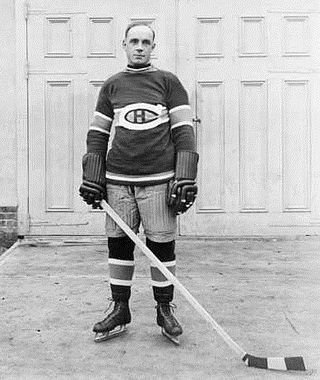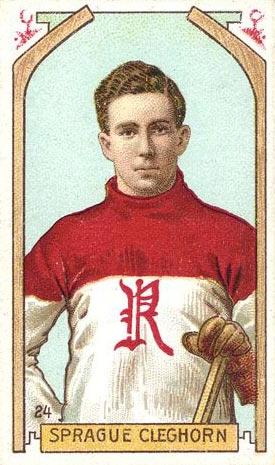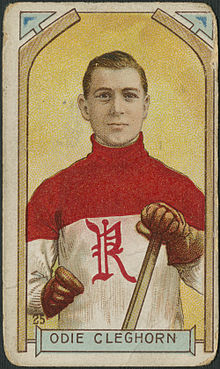
The Pittsburgh Pirates were an American professional ice hockey team in the National Hockey League (NHL), based in Pittsburgh from 1925–26 to 1929–30. The nickname comes from the baseball team also based in the city. For the 1930–31 season, the team moved to Philadelphia, and played one season as the Philadelphia Quakers.

Curtis Lester Patrick was a Canadian professional ice hockey player and coach associated with the Victoria Aristocrats/Cougars of the Pacific Coast Hockey Association, and the New York Rangers of the National Hockey League (NHL). Along with his brother Frank Patrick and father Joseph Patrick, he founded the PCHA and helped develop several rules for the game of hockey. Patrick won the Stanley Cup six times as a player, coach and manager.

Wilfrid Arthur "Billy" Coutu, nicknamed "Wild Beaver", was a Canadian professional ice hockey defenceman who played ten seasons in the National Hockey League for the Montreal Canadiens, the Hamilton Tigers, and the Boston Bruins. Known for his fiery temper, Coutu was once given 42 penalty minutes in a 1923 playoff game against the Ottawa Senators, still a record to this day. He is the only player ever to have been banned from the NHL for life, as a result of his attack on a referee in 1927.

Henry William Sprague "Peg" Cleghorn, also known as "The Big Train", was a Canadian professional ice hockey player from Westmount, Quebec who played 17 professional seasons between 1911 and 1929 for the Renfrew Creamery Kings and Montreal Wanderers in the National Hockey Association (NHA) and the Ottawa Senators, Montreal Canadiens and Boston Bruins in the National Hockey League (NHL). He was a member of three Stanley Cup championship teams, winning with the Senators in 1920 and 1921 as well as with the Canadiens in 1924. His brother Odie was also a professional player and the two played several seasons together.
The 1921–22 NHL season was the fifth season of the National Hockey League (NHL). Four teams each played 24 games. The league dropped the split season and the two top teams played off for the league championship. The second-place Toronto St. Patricks defeated the first-place Ottawa Senators for the league championship.
The 1925–26 NHL season was the ninth season of the National Hockey League (NHL). The NHL dropped the Hamilton Tigers and added two new teams, the New York Americans and the Pittsburgh Pirates, to bring the total number of teams to seven. The Ottawa Senators were the regular-season champion, but lost in the NHL playoff final to the Montreal Maroons. The Maroons then defeated the defending Stanley Cup champion Victoria Cougars of the newly renamed Western Hockey League three games to one in a best-of-five series to win their first Stanley Cup.

François Xavier Boucher was a Canadian professional ice hockey player and executive. Boucher played the forward position for the Ottawa Senators and New York Rangers in the National Hockey League (NHL) and the Vancouver Maroons in the Pacific Coast Hockey Association (PCHA) between 1921 and 1938, and again from 1943 to 1944. Boucher later became coach and the general manager of the New York Rangers between 1939 and 1955. He won the Stanley Cup three times, all with the Rangers: in 1928 and 1933 as a player, and in 1940 as the coach. Boucher was inducted into the Hockey Hall of Fame in 1958. Three of his brothers also played in the NHL, including Georges, who was also inducted into the Hockey Hall of Fame.

Edward George Gerard was a Canadian professional ice hockey player, coach, and manager. Born in Ottawa, Ontario, Canada, he played professionally for 10 seasons for his hometown Ottawa Senators. He spent the first three years of his playing career as a left winger before switching to defence, retiring in 1923 due to a throat ailment. Gerard won the Stanley Cup in four consecutive years from 1920 to 1923, and was the first player to win the Cup four consecutive seasons. After his playing career he served as a coach and manager, working with the Montreal Maroons from 1925 until 1929, winning the Stanley Cup in 1926. Gerard also coached the New York Americans for two seasons between 1930 and 1932, before returning to the Maroons for two more seasons. He ended his career coaching the St. Louis Eagles in 1934, before retiring due to the same throat issue that had ended his playing career. He died from complications related to it in 1937.
The 1945–46 NHL season was the 29th season of the National Hockey League. The Montreal Canadiens won the Stanley Cup, defeating the Boston Bruins for the team's sixth championship.
The 1927–28 NHL season was the 11th season of the National Hockey League. Ten teams played 44 games each. This was the first full season that the Toronto club used the Toronto Maple Leafs name following ownership changes in February 1927. The New York Rangers won the Stanley Cup beating the Montreal Maroons, becoming the first NHL team based in the United States to win it.
The 1928–29 NHL season was the 12th season of the National Hockey League. Ten teams played 44 games each. This was the first Stanley Cup Finals that saw two United States–based teams compete for the cup. The Boston Bruins defeated the New York Rangers two games to none in the best-of-three final.

James Cooper Smeaton was a Canadian professional ice hockey player, referee and head coach. He served referee-in-chief of the National Hockey League (NHL) from 1917 until 1937. Smeaton served as a Stanley Cup trustee from 1946 until his death in 1978. He was inducted into the Hockey Hall of Fame in 1961.

The Pittsburgh Shamrocks were a professional ice hockey team, based in Pittsburgh, Pennsylvania that played in the International Hockey League in 1935–36. The team played all of its home games at Duquesne Garden. During their lone season in existence, the Shamrocks finished in fourth place in the West Division behind the Detroit Olympics, Cleveland Falcons, and Windsor Bulldogs. The Shamrocks scored 137 goals and allowed 170. The team folded after one season. It is estimated that the team lost $36,000 during 1935–36 season.
The 1923 Stanley Cup Finals was contested by the NHL champion Ottawa Senators and the WCHL champion Edmonton Eskimos. The previous WCHL-PCHA playoff format was abandoned, and the Ottawa Senators now had to play first the PCHA champion Vancouver Maroons, followed by the WCHL champion Edmonton Eskimos in the Finals.

The 1924 Stanley Cup Finals saw the National Hockey League (NHL) champion Montreal Canadiens defeat the Western Canada Hockey League (WCHL) champion Calgary Tigers two games to none in the best-of-three-game series. It was Montreal's fourth appearance in the Finals and second championship.
The 1928 Stanley Cup Finals was a best-of-five series played entirely in Montreal between the New York Rangers and the Montreal Maroons. It was the first appearance by the Rangers in the Finals in only their second season. The Maroons made their second Finals appearance after winning the Stanley Cup in 1926. The Rangers won the series three games to two to earn their first championship in franchise history; this was also the second Stanley Cup victory by an American-based team, and the first since the Seattle Metropolitans in 1917. This was also the first of only two times that a Montreal-based team lost the clinching game of the Stanley Cup Finals at home in the Montreal Forum, the other occurred in 1989 when the Calgary Flames defeated the Montreal Canadiens. This was the last Stanley Cup Finals to be played in one location until the pandemic shortened season of 2020.
The 1921–22 Montreal Canadiens season was the team's 13th season and fifth as a member of the National Hockey League (NHL). The Canadiens, for the third season in a row, did not qualify for the playoffs, finishing third.
The 1925–26 Montreal Canadiens season was the team's 17th season and ninth as a member of the National Hockey League (NHL). The Canadiens lost their star goalie Georges Vezina to tuberculosis and struggled as a team, not making the playoffs. The league added teams in Pittsburgh and New York, New York taking the players of the former Hamilton Tigers franchise.
The 1926–27 Boston Bruins season was the team's third in the NHL. The Bruins finished second in the American Division, making the playoffs for the first time in franchise history. The team competed in the first Stanley Cup finals to be held exclusively between NHL teams, losing to the Ottawa Senators.
The 1925–26 Pittsburgh Pirates season was the first season of the new Pirates ice hockey team in the National Hockey League. The club made the playoffs in its first season after placing third in the league. The Pirates lost in the playoffs to the eventual Stanley Cup champion Montreal Maroons.









